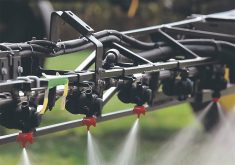Bats in your belfry? Or rather, your barn or attic?
“If you know that you have bats in your house, chances are it’s because there is not a good habitat for them somewhere else,” says conservation technician Lisa Card. “Most species would rather not be there, but their habitat has been altered and for whatever reason, they can’t find suitable roosting habitat.”
Most people realize they have a bat problem when they hear them inside their house. There’s usually more than one, and likely a maternal bat colony. Bats have their pups between late May and August, and although big brown bats will hibernate in buildings, most species will vacate the premises in late August. It’s best to leave them alone during the summer.
Read Also

VIDEO: Claas Axion 9 tractors showcase comfort features
German equipment manufacturer Claas showcased its new Axion 9 tractor series, including farmer-focused cab features, at the Agritechnica 2025 machinery show in November.
- More on the Alberta Farmer: Misunderstood bats don’t deserve their bad rap
“This is not a good time to do bat exclusion because you will lock in the babies, and they will die and stink up your house,” said Card.
Not all bats will leave the house every night either.
The best time to do bat exclusion is in late fall, before it snows.
“If you have bats in your home in the summer, use the summer as an experiment to see where they come in and out. They will usually have more than one exit or entry into the house. Watch and see where you will need to block it in the fall.”
Most bats are very loyal to their maternal colonies and will make every effort to return to the same roost. They can squeeze into spaces that are smaller than the diameter of a pencil.
“If they think your place is great, they will make every effort to come back to your place, so you need to be very thorough in blocking every single hole that a bat can get into,” she said.
















